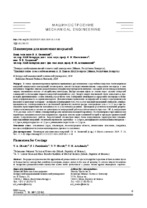| dc.contributor.author | Оковитый, В. А. | |
| dc.contributor.author | Пантелеенко, Ф. И. | |
| dc.contributor.author | Оковитый, В. В. | |
| dc.contributor.author | Асташинский, В. М. | |
| dc.coverage.spatial | Минск | ru |
| dc.date.accessioned | 2019-02-11T09:54:18Z | |
| dc.date.available | 2019-02-11T09:54:18Z | |
| dc.date.issued | 2019 | |
| dc.identifier.citation | Плазмотрон для нанесения покрытий = Plasmatron for Coatings / В. А. Оковитый [и др.] // Наука и техника. – 2019. – №1. – С. 5-10. | ru |
| dc.identifier.uri | https://rep.bntu.by/handle/data/49661 | |
| dc.description.abstract | В статье проанализированы причины применения для напыления жаростойких подслоев теплозащитных
покрытий специальных конструкций плазмотронов, способствующих минимальному содержанию кислорода в зоне
напыления. Подробно описана разработанная авторами конструкция плазмотрона с насадкой, позволяющая улучшить защиту плазменного потока от воздействия атмосферы. Внутрь насадки вдоль ее стенок через систему отверстий в концевой части насадки подается нагретый инертный газ (Аr). Воздух вокруг плазменной струи вытесняется, происходит дополнительное сжатие плазмы, в результате чего в покрытии уменьшается содержание кислорода и повышается эффективность осаждения материала. Дополнительное применение вольфрамовой вставки в электронном узле позволит создать пару вольфрам – вольфрам в электродном узле, что за счет высокой эрозионной стойкости, электропроводимости, теплопроводности и достаточной прочности увеличит ресурс электродного узла в 2–2,5 раза при повышении производительности напыления из-за ужесточения режимов. Приведены результаты испытаний разработанного плазмотрона и аналога на длительность непрерывной работы и интенсивность при токе 500 А, напряжении 70 В, расходе азота 45 л/мин (стандартный режим напыления оксидной керамики). На плазмотронах при одинаковых параметрах напыления получены покрытия из порошка никель–хром–алюминий–иттрий и проведен сравнительный анализ технологических свойств. Разработанный плазмотрон имеет более качественные характеристики плазменных подслойных покрытий: увеличение прочности сцепления – в 1,4 раза, коэффициента использования материала – в 1,3 раза, микротвердости – в 1,3 раза, уменьшение пористости – в 2,3 раза. | ru |
| dc.language.iso | ru | ru |
| dc.publisher | БНТУ | ru |
| dc.title | Плазмотрон для нанесения покрытий | ru |
| dc.title.alternative | Plasmatron for Coatings | ru |
| dc.type | Article | ru |
| dc.identifier.doi | 10.21122/2227-1031-2019-18-1-5-10 | |
| local.description.annotation | The paper analyzes reasons for application of plasma torches of special design for deposition of heat-resistant layers
of thermal barrier coatings that contribute to minimum oxygen content in the zone of spraying. It contains detailed description of design for a plasma torch with a nozzle that allows better protection of a plasma stream against atmospheric exposure. Heated inert gas (Ar) is fed inside the nozzle along its walls through holes in its end part. Air around a plasma jet is displaced, additional compression of the plasma occurs and due to this oxygen content is decreased in a coating and efficiency of material deposition is increased. An additional use of a tungsten insert in an electronic node makes it possible to create a pair of tungsten – tungsten in an electrode assembly and the life of the electrode assembly will be increased due to high erosion resistance, electrical conductivity, thermal conductivity and sufficient strength in 2–2.5 times while increasing spray performance through toughening regimes. The paper presents testing results of the developed plasma torch and its prototype for duration of continuous operation and intensity at 500 A current, 70 V voltage, nitrogen flow rate of 45 l/min (standard mode for deposition of oxide ceramics). Coatings from nickel–chromium–aluminum–yttrium powder have been obtained while using plasma torches with the same parameters of deposition and a comparative analysis of the technological properties have been made in the paper. The developed plasma torch has more qualitative characteristics of subsurface plasma coatings: increase in adhesive strength – by 1.4 times, material utilization ratio – by 1.3 times, micro-hardness – by 1.3 times, porosity decrease – by 2.3 times. | ru |

